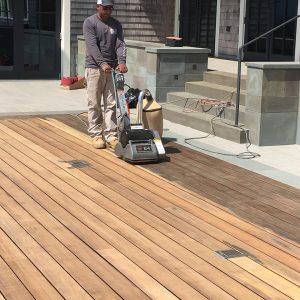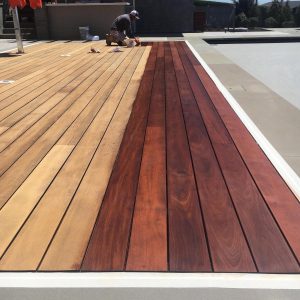
New England weather doesn’t go easy on decks. Between coastal humidity, freezing winters, and salty air, wood structures take a beating year-round. That’s why regular maintenance isn’t just cosmetic, it’s essential to protect your investment.
But how do you know when it’s time to repair, paint, or seal your deck? Let us review some warning signs that shouldn’t be ignored!
- Peeling, Cracking, or Fading Paint/Stain
Paint and stain aren’t just for looks—they’re your deck’s first line of defense. If you notice flaking, chipping, or dull color, your deck is likely exposed to moisture and UV damage. A fresh coat of high-quality sealant or stain can prevent deeper structural issues.
- Soft, Spongy, or Rotting Wood
Step on a board and it feels soft? That’s a red flag. Moisture infiltration can lead to rot, especially in older decks or those shaded most of the day. Any wood that feels spongy, smells musty, or crumbles at the edges needs attention immediately.
- Visible Cracks or Splits in Boards
Wood naturally expands and contracts with the seasons, but over time, this causes cracks. Small surface cracks are normal, but deep splits or warping can compromise safety and lead to splintering. It may be time to replace damaged boards and re-seal the surface.
- Loose Nails, Screws, or Railings
If you notice nails popping up, loose fasteners, or shaky railings, it’s more than just a nuisance…it’s a safety hazard! These issues often go hand-in-hand with structural weakening and should be repaired before painting or sealing.
- Discoloration from Mold or Mildew
Grey-green patches, especially in shady or damp areas, often indicate mold, algae, or mildew. Not only is this unsightly, but it makes the deck slippery and can eat away at your wood over time. Soft washing the surface, followed by sealing is key to prevention.
- Water No Longer Beads on the Surface
Here’s a quick test: sprinkle some water on your deck. If it absorbs immediately instead of beading up, your sealant has worn off, leaving your wood vulnerable. Reapplying a quality water-repellent sealer is crucial—especially before fall and winter hit.
- Insect Damage or Hollow Sounds
Termites, carpenter ants, and other wood-loving pests thrive in moist, untreated wood. Tap suspect boards with a screwdriver, a hollow sound could signal internal damage. Addressing this early can save you thousands in structural repairs later.

We recommend addressing these issues sooner rather than later. September and October are still ideal times to repair and protect your deck. There is still enough warmth for products to cure properly and getting ahead of the winter rain and snow will help avoid expensive damage down the line. Your deck is an outdoor extension of your home – don’t let it fall apart quietly.
Ready to give your deck the care it deserves? Contact us today for a free estimate





